Trip Report – 7 – 13 January 2015 : Nelson Lakes National Park & vicinity Summer Camp
For a wonderful field trip in every way, we thank: Mick (leader), Graeme and Gael for providing plant lists, Shannel for guiding us on Beebys Knob and Red Hills, vehicle drivers, Robyn (quiz organiser), Richard and Yvonne, owners of Travers Sabine Lodge, our ideal base, Bev (lunch & breakfast foods), Fiona & Mikayla Borlase and Lyn Baigent, chefs of wonderful dinners, the owners of land on the approaches to Beebys Knob, Red Hills and Rainbow Skifield, DOC staff for advice and keys, Canterbury BotSoccers for joining us for a day, and ‘Hughie’ for providing ideal weather for 39 happy BotSoccers.
Day 1 – 8.1.15: Lower Porika shrubland
Early morning low cloud and a cool wind led to us to explore the Porika Stream valley and along Howard Valley Rd, an area with a complex variety of small-leaved shrubs. We saw ten coprosmas, three pittosporums,
Aristotelia fruticosa, three gaultherias,
Corokia cotoneaster,
Raukaua simplex,
Melicytus flexuosus and three hebes. Most discussed were
Pittosporum anomalum,
P. divaricatum and
P. ridgidum.
Favourite plants or experiences of the day, other than the fascinating array of small-leaved shrubs, were “putputaweta in full flower”, “learning to recognise mature
Raukaua simplex”, “
Myositis forsteri in flower”.
Our lichenologists found species associated with pastoral and shrubland sites. Others commented on the intertwined diversity of the plant community. We made 20-30 additions to the existing list.
Sheelagh Leary
Day 2 – 9.1.15: Beebys Knob (1,317 m)
Beebys Knob, our first experience of the region’s alpine flora, was our only taste of bad weather. We donned warm jackets, balaclavas and mittens as we left the 4WDs at the bush line. By lunch time, the cloud had cleared, the sun emerged, and we were rewarded with views of Lake Rotoiti, St Arnaud Range, Mt Robert, Wairau Valley and the Raglan Range.
At ground level, carpet grass (
Chionochloa australis) and
C. pallens formed a mosaic with dense patches of
Celmisia sessiliflora, almost impenetrable by other plants. Delights in flower included gentians, a craspedia, two euphrasias, and a brachyglottis. We found
Montia calycina and
Raoulia grandiflora on bare areas fractured by frost-heave or track construction. Shrubs near the bushline included bog pine /
Halocarpus bidwillii and a confusion of coprosmas, e.g.,
C. fowerakeri,
C. cheesemanii and
C. depressa.
We learned again the benefits of binoculars for long-distance botany. Shannel spotted from afar what looked like aciphyllas quite near our vehicles. An old female spike enabled us to identify them as
A. aurea. With signs of pig-rooting nearby, it was good to see many young plants nearby.
More energetic members tramped up from the Korere – Tophouse Road before continuing along the 4WD track to Beebys Knob Hut.
Bev Abbott
Day 3 – 10.1.15: Red Hills
The day dawned fine and stayed that way for a full day trip above the bush line. Shannel described the geology that made this area botanically unique. He explained how the meeting of the Pacific and Australian tectonic plates resulted in the heavier sea-floor rock being exposed in this area. The high iron content, and other minerals, e.g., chromium, nickel and cobalt, provide a substrate that is toxic to many species, but suits a few plants found only in mineralised ‘ultramafic’ geological formations.
In the beech forest below Red Hill Hut, we saw the sudden change from (relatively) smooth greywacke to the bumpy road over serpentine rock. Equally striking were the well-grown red and silver beech on the greywacke, differing from the stunted mountain beech, mountain cedar and shrubs on the ultramafic substrate. Later, lunching on a stack of greywacke forming an island in the serpentine-based tussock, we noticed that it was mountain beech providing shade for us, and for shrubs and herbs that were not found in the surrounding ‘ultramafic sea’.
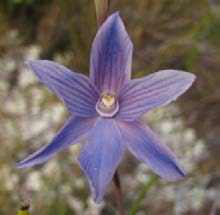 |
Thelymitra cyanea
|
At Red Hills Hut, Shannel worked through the plant list to identify the 24 “mineral favouring” plants, endemic to the ultramafic substrate. Then it was a botanising-paced walk up the ridge behind the hut through tussock and shrubland. The dominant shrub, manuka, was in flower. Soon we came to the mineral-loving plants:
The short tussock,
Chionochloa defracta, filled spaces between the shrubs, and higher up, formed an almost pure tussock land. We found
Coprosma “rimicola” , with its banana-shaped leaves, hiding in rock crevices. Shannel introduced us to the thick-leaved
Hebe carnosula, and left us arguing over the variable shape of the sinus. (“Pin hole, long shield, oval, short cathedral”, were some of the descriptions bandied about).
Pimelea suteri was rather shy, and although we did find some, we saw it in flower only beyond the first ridge line. After seeing the russet-coloured,
Carex devia, with its single upright seed-head, topped by a small male inflorescence, we found several as we climbed further.
Two mineral-favouring colobanthus,
C. “serpentine” and
C. “Red Hills” baffled us with the difference between them. We could identify
Astelia “serpentine”, with rather wider leaves than the related
A. graminea, and with more red colouring.
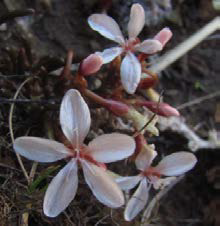 |
Montia racemosa
|
It was the flowering
Notothlaspi australe and
Craspedia “serpentine” that caught the photographers’ eye. However these plants could not compete with the patches of deep-blue-flowered
Thelymitra cyanea, and the tiny
Montia racemosa, when it came to being photographed.
We had started the day with a plant list based on Tony Druce’s 1993 list. The only plants we could add were a tiny uncinia,
U. involuta,
Myosotis laeta,
Thelymitra hatchii and
Coprosma fowerakeri. This is a reflection on Tony’s thorough botanical surveying, rather any failure to look on our part.
Barbara Hammonds, Rodney Lewington
Day 4 – 11.1.2015: Parachute Rock Track & beyond
Some went to Parachute Rock, just beyond the treeline – a long, hard, climb up a zigzag in seemingly endless beech forest – and some went beyond, to the St Arnaud Range crest, and over the other side to some tarns.
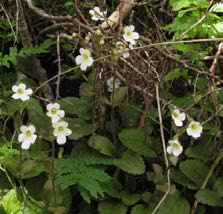 |
Ourisia macrophylla subsp. Lacteal
|
In the forest we were stopped in our tracks by a patch of bright yellow slime-mould. It had small projections from the surface, visible through a hand lens. On the descent, four hours later, it was deflated, looking distinctly past its best.
A trip down a ‘closed’ track revealed a wet area in the otherwise dry forest, with masses of flowering
Ourisia macrophylla subsp.
lacteal, new to some of us. This spot had a sign ‘Fragile Area’ – perhaps people had trampled the plants to access the water?
We saw the delicate orchid,
Adenochilus gracilis, flowering in small patches along track edges. It caught the fancy of a passing tramper. This was an addition to the list, as was
Simpliglottis cornuta and
Viola filicaulis, also along track edges.
There are great views of Lake Rotoiti and St Arnaud from Parachute Rock, but some of us were keen to see what lay over the ridge, so continued up the steep path to the ridge through the tussock. We saw small, soft, spaniard,
Aciphylla monroi, among the grass, and penwipers /
Notothlaspi australe in magnificent flower on a scree slope.
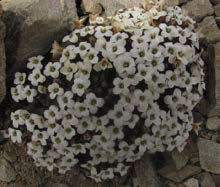 |
Notothlaspi australe
|
On the ridge top we saw the first vegetable sheep on the trip,
Raoulia bryoides. They received obligatory raps with knuckles to hear their hollow, woody, sound. They are of course listed with the trees and shrubs, not the daisy-like herbs - takes time for some of us to remember that!
Down to the tarns, via tussock slopes, then scree - with
Parahebe cheesemanii also seen for the first time, then very stable talus, whose rocks were covered with a geography of crustose lichens, and then more tussock grading into damp swards around seepages and the tarn edges.
The swards contained rich assemblages of plants, e.g.,
Montia angustifolia,
Galium perpusillum and
Drosera arcturi, all in flower, an
Abrotenella and
Ranunculus gracilipes.
Birds seen or heard in the forest included: kaka, kakariki, riflemen and whitehead.
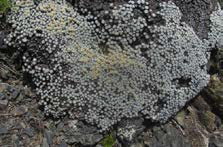 |
Raoulia bryoides
|
Barbara Hammonds
Day 4 – 11.1.2015: Black Valley – St Arnaud Range Track – Loop Track
South Island toetoe /
Austroderia richardii and
Chionochloa conspicua mark the start of this pleasant walk from Travers – Sabine Lodge along Black Stream to Kerr Bay, Lake Rotoiti. Trackside en route we noted that every planted seedling of
Pittosporum patulum had been protected by a rabbit-proof enclosure, further evidence of the work that the Friends of the Rotoiti Nature Recovery Project do in addition to maintaining many trap stations. Bellbirds / korimako were vociferous, courtesy of the Friends’ sustained pest control. In the forest, a fallen leaf had us puzzled. Later Graeme agreed that it had to be from one of the mistletoes up in a beech tree, too high to identify,
At Kerr Bay, a weka called, and on the vast lawn, black-billed gulls squalled. Here we saw a giant Douglas fir, a weed species which invades indigenous plant communities. We wondered that it has been left to naturalise in this relatively indigenous setting. An excellent information panel describes DOC’s wide-ranging
Battle for our Birds campaign, here an integral part of the Rotoiti Nature Recovery Project which began in 1997. It involves using 1080 to kill rodents, mustelids and hedgehogs. 2015 is a beech ‘mast’ year, so using 1080 to kill pest animals is essential, otherwise predation will drastically reduce beech seed germination, and native fauna populations.
On the St Arnaud Range Track, we were impressed by the tall cedars –
Libocedrus bidwillii, compared Hall’s totara and needle-leaved totara, and checked the wrap-around stipules on
Coprosma linariifolia. Despite the menacing buzz of wasps stealing honey-dew from beech trees, none of us got stung. The weed,
Juncus effusus, infested the sides of track. On this track, and on the Loop Track, we saw four species of beech: black, red, silver and mountain,
Blechnum montanum / mountain kiokio,
Cyathea colensoi / mountain tree fern,
Raukaua simplex / haumakaroa,
Lagenophora pinnatifida, and
Gentianella bellidifolia / small snow gentian.
Barbara M, Margaret H, Chris H.
Day 5 – 12.1.15: Rainbow Ski Area
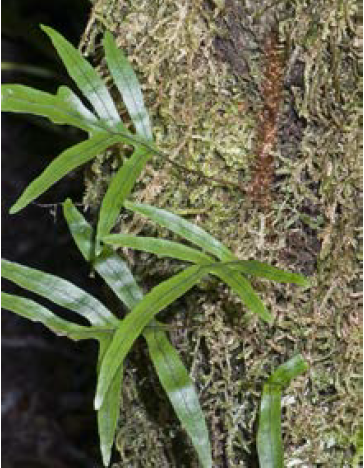 |
Rainbow_Ski_Area_2015. Photo: Ian Goodwin.
|
It was a clear, hot, sunny day for the drive up the ski field road. We had paid a key fee, so were grateful for the altitude gained so easily. Small groups scattered from the car park to seek their favourite type of terrain. Allison Knight, Bill and Nancy Malcolm drove higher up, and in the rocky area on the true left of the ski-field, found many interesting lichens. Lara and Leon climbed to the heights on the true right, sidling around the top of the basin, to later meet the lichenologists. Their botanical highlights were
Myosotis traversii and
Haastia pulvinaris, a vegetable sheep. Another group climbed to the ridge, then went south along it over Mt McRae. They found a Canada goose and goslings on a tarn, and Dale swam in a goose-free tarn beyond. They enjoyed seeing the penwiper,
Notothlaspi rosulatum.
The main group meandered across the disturbed land at the bottom of the ski-field, finding tiny
Montia calycina in flower. We clambered up a rich alpine stream, admiring
Dolichoglottis lyallii with its bright-yellow flowers,
Craspedia uniflora, giant buttercups,
Viola cunninghamii, vegetable sheep /
Raoulia eximia, an
Aciphylla c. 2 cm high with leaves 3 cm long, and other sub-alpine flowering plants, ferns and shrubs.
 |
Notothlaspi australe. Illustration: Eleanor Burton.
|
We circled a rocky tarn, saw blue-green cushions of
Chionohebe pulvinaris, with tiny leaves and whiskery hairs, and had lunch #1 by a large rock above a tarn. The tiny, very hairy
Coprosma atropurpurea, with a fringe of male flowers, waved its stamens. Across a scree basin we saw
Notothlaspi rosulatum, tiny, purple
Parahebe cheesemanii in flower,
Chionohebe pulvinaris,
Haastia sinclairii, and the very firm, dense,
Hebe epacridea.
On the skyline, we enjoyed wide and distant views to Lake Rotoiti and St Arnaud, and the ranges all around. Dramatic, threatening, dark clouds came to nothing. We had lunch #2 in a sheltered spot just below the ridge, looked at more sub-alpines, then descended to the cars.
On the drive down, the last car made an unplanned stop at a pretty waterfall and a green bank of densely flowering Ourisia, and nearly got locked in for the night!
At camp we had an after-dinner quiz, seven teams and 20 questions. The winners were Table 3: Barbara C, Lara S and Mick P.
Ian and Jill Goodwin
Day 6 – 13.1.15: Upper Wairau Valley
For this, our final foray, we had to fit most of us into 4WD vehicles needed to ford Six Mile Creek, just past the Rainbow Skifield turnoff. However, Tony Aldridge showed remarkable skill in negotiating the ford with his 2WD ute, which gave us the capacity to take 18 members comfortably for the next 41 km. We aimed to reach Island Pass at the headwaters of both the Wairau and Clarence Rivers.
First stop: a heavily grazed outwash fan with patches of
Coprosma propinqua, shapely
C. tayloriae, and very grey
Ozothamnus vauvilliersii. Among the pasture sward that included sheep’s burnet /
Sanguisorba minor, were
C. atropurpurea, the more hairy
C. petriei, and
Gaultheria macrostigma. Herbs included
Acaena novae-zelandiae,
Chaerophyllum colensoi and
Anisotome aromatica.
Second stop: a dry, shaded, bank, with
Aristotelia fruiticosa, with its rounder leaves perhaps indicating it was a hybrid, and the ferns
Asplenium flabellatum and
A. richardii. On the edges of a wetter area nearby were large
Polystichum vestitum.
Third stop: Past the old Rainbow Homestead, and just beyond Wairau Gorge, is an old riverbed with what appeared to be mainly yarrow /
Achillea millefolium, and some low, grey, scrub. On second take, it was the unusual
Helichrysum depressum, with its ‘dry stick’ appearance. Also scattered about was
Epilobium melanocaulon, and a hebe with black stems and red leaf edges that we couldn’t name. Other notable plants included
Gaultheria depressa among much large, red-flowered,
Trifolium pratense.
We saw trout (a.k.a. possums-of-the-waterways), in the river, as we passed dusty avenues of ragwort / Jacobaea vulgaris, and viper’s bugloss /
Echium vulgare, interspersed with foxglove /
Digitalis purpurea, until the countryside opened out before reaching Sedgemere gate, the entrance to Molesworth Station.
Fourth stop: Here we paused in the heat, and among the rocks saw
Raoulia subericea and
R. hookeri, with its obvious ray floret, and a
Prasophyllum colensoi among the scattered bristle tussock /
Rytidosperma setifolium,
Dracophyllum rosmarinifolium and
Acrothamnus colensoi. On a rocky outcrop and scree face just above the river, there was a penwiper,
Notothlaspi rosulatum. Among the rocks we saw
Hebe brachysiphon,
H. traversii, amid bushes of
H. parviflora,
Discaria toumatou,
Helichrysum coralloides,
Melicytus alpinus,
Bulbinella hookeri, and some small
Aciphylla aurea.
Fifth stop: Island Saddle. By the time we got here we were more familiar with the names of the alpine flora previously unfamiliar to most of us. Up on the scree, we found
Leptinella atrata,
Stellaria roughii,
Epilobium pycnostachyum, and numerous penwipers. Led to the ridge-top by Barbara Mitcalfe, we found among outcrops of dry moss,
Lignocarpa carnosula, the woolly
Pimelea sericeovillosa agg.,
Acaena glabra and
Anisotome filifolia.
It was now time to return, to pack up, and to enjoy dinner! It was a fitting way to end the trip for which Graeme Jane had expertly chosen the spots from which we would learn most, in settings unfamiliar to most of us.
Mick Parsons
Participants: Bev Abbott, Tony Aldridge, Robyn Bridges, Eleanor Burton, Barbara Clark, Shannel Courtney, Gavin Dench, Michele Dickson, Gael Donaghy, Dale Every, Ken Fraser, Ian and Jill Goodwin, Alyth Grant, Bryan and Robin Halliday, Barbara Hammonds, Margaret and Richard Herbert, Chris Horne, Sheena and Stuart Hudson, Graeme Jane, Brenda Johnston, Allison Knight, Sheelagh Leary, Rodney Lewington, Bill and Nancy Malcolm, Barbara Mitcalfe, Syd Moore, Mick Parsons (leader), Leon Perrie, Lara Shepherd, Darea Sherratt, Barbara Simmons, Sunita Singh, Val Smith, Julia Stace.

 Site Index
Site Index







 Site Index
Site Index





